Play
Part 1 - Step by Step
- InstructInstruct students that they are going to participate in the Landslide! Competition with their Hero Robots. First, they will practice for the competition by driving the Hero Robot to trigger a landslide and try to move one rock to the Red Tile on the Field. View the video below to learn more about the game elements, driving, and scoring for the Landslide Lab activities. The end of the video shows an example of how a Hero Robot could drive to accomplish the tasks in the Lab.
Note: You can choose how students interact with the video content. The video is embedded within the Lab 4 Image Slideshow to share easily with students. Or, you may choose to watch the video yourself and present the information to your students in class.
- ModelModel Model for students how to drive the Hero Robot to trigger the landslide and clear the roadway. The goal of this practice is to use the Hero Robot to trigger a landslide, and then move one rock to the Red Tile.
First, model for students how to launch VEXcode GO, connect their Brain to their device, and open the Drive tab.

Select the Drive Tab - Note: When you first connect your robot to your device, the Gyro built into the Brain may calibrate, causing the robot to move on its own for a moment. This is an expected behavior; do not touch the robot while it's calibrating.
- Next, model for students how to select the Motor option in Port 2, to control the arm motor on the Hero Robot.
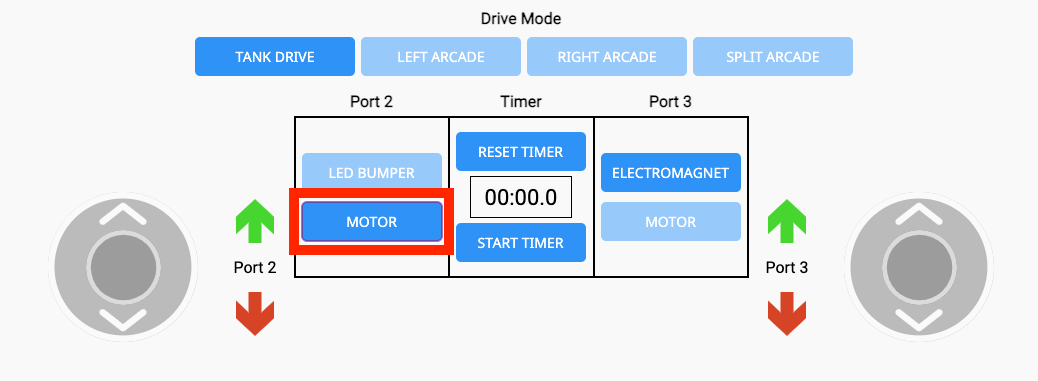
Select the Motor Option for Port 2 -
Model for students how to change the Drive Mode by selecting the buttons – Tank Drive, Left Arcade, Right Arcade, or Split Arcade. View the video clip below to see the movement of the joysticks as each Drive Mode is selected.
Video file- For reference, the Drive Modes correspond to the following controls:
- Tank Drive: Each joystick controls a different motor.
- Left Arcade: One joystick that controls both motors. The joystick is on the left-hand side of the screen.
- Right Arcade: One joystick that controls both motors. The joystick is on the right-hand side of the screen.
- Split Arcade: Two joysticks. One controls left and right movements and the other controls forward and reverse movements.
- For reference, the Drive Modes correspond to the following controls:
- Model for students how to raise and lower the arm motor using the green and red arrows around Port 2.
- Note: The arrows correspond to the direction the motor is spinning, not necessarily the up and down movements of the arm itself.
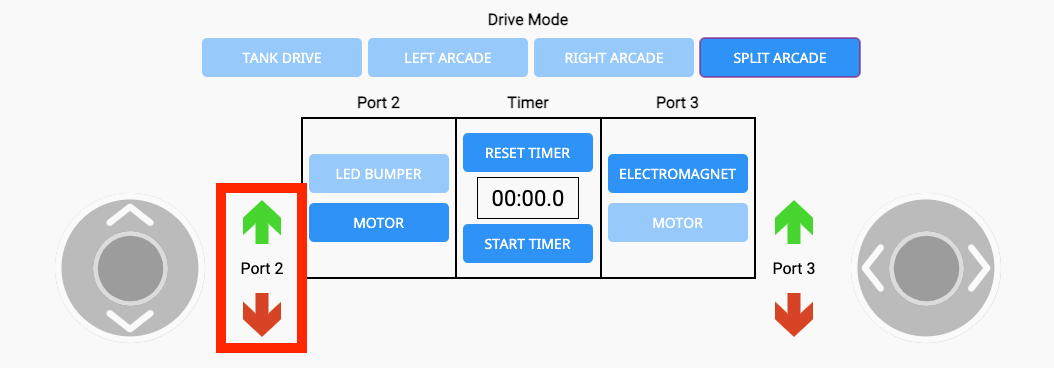
Port 2 Motor Controls -
Next, set the Hero Robot on the green starting Tile, and model how to drive to trigger the landslide and move one rock over to the Red Tile on the Field using the Drive tab as shown in the video in the Instruct step.
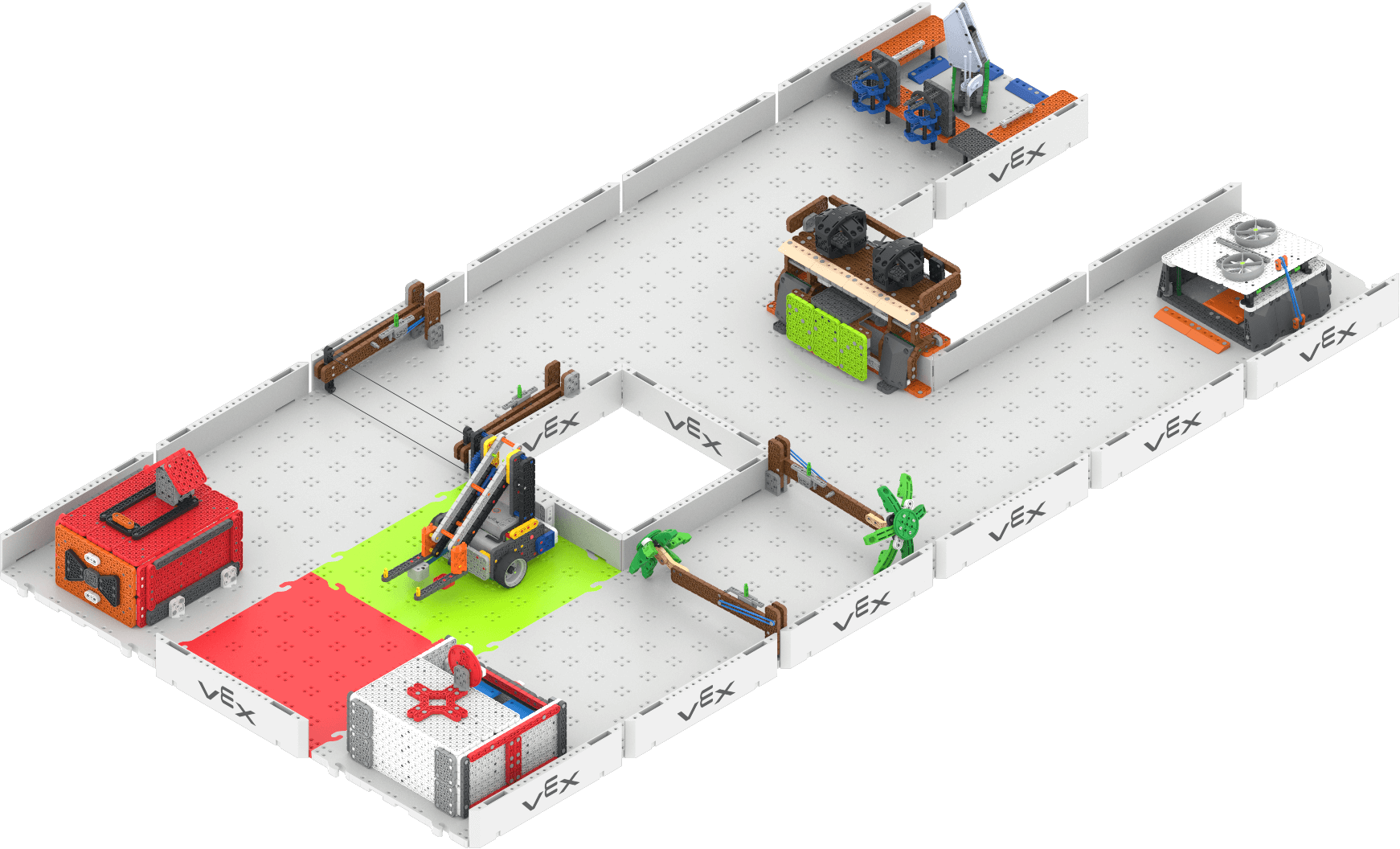
Field Setup - As students are practicing driving the Hero Robot to trigger the landslide and move the rock, you can use the Landslide! Practice Activity (.docx / .pdf) to guide them through how to practice.
-
If students finish the practice tasks early, and need an additional challenge, have them try one of the 'Level Up' extensions on the Landslide! Practice Activity.
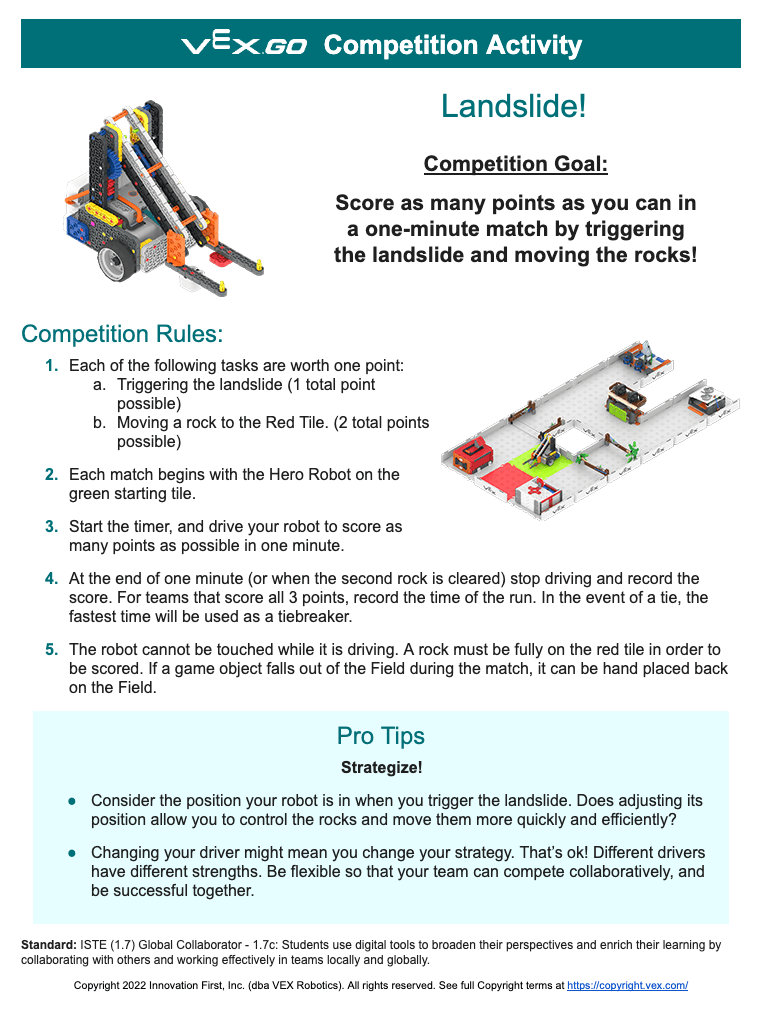
Landslide! Practice Activity
-
- FacilitateFacilitate Facilitate turn taking and collaboration between and among teams as they are practicing driving their Hero Robots. As you circulate around the room, ask questions like:
- How are you taking turns driving on your team, so everyone has a chance to practice?
- As you practice, what do you notice about triggering the landslide that makes it easier to accomplish?
- Can you come up with more than one way to use the Hero Robot to move the rock? Which way is the fastest? The easiest?
- What can you learn from each other's driving strategies to trigger the landslide and move a rock that can help your team in the competition?
You may want to have multiple areas for practice set up around the room. While there is only one Landslide Tile on the Stage 4 Field, you can offer students space to practice pushing into an object, and moving rocks. Use classroom objects to represent the landslide mechanism and extra pieces from the VEX GO Kit to create objects that are similar to the rocks to use for practice, so that students can test design or driving strategy ideas off the Field. Use this image of the rock game objects for reference.
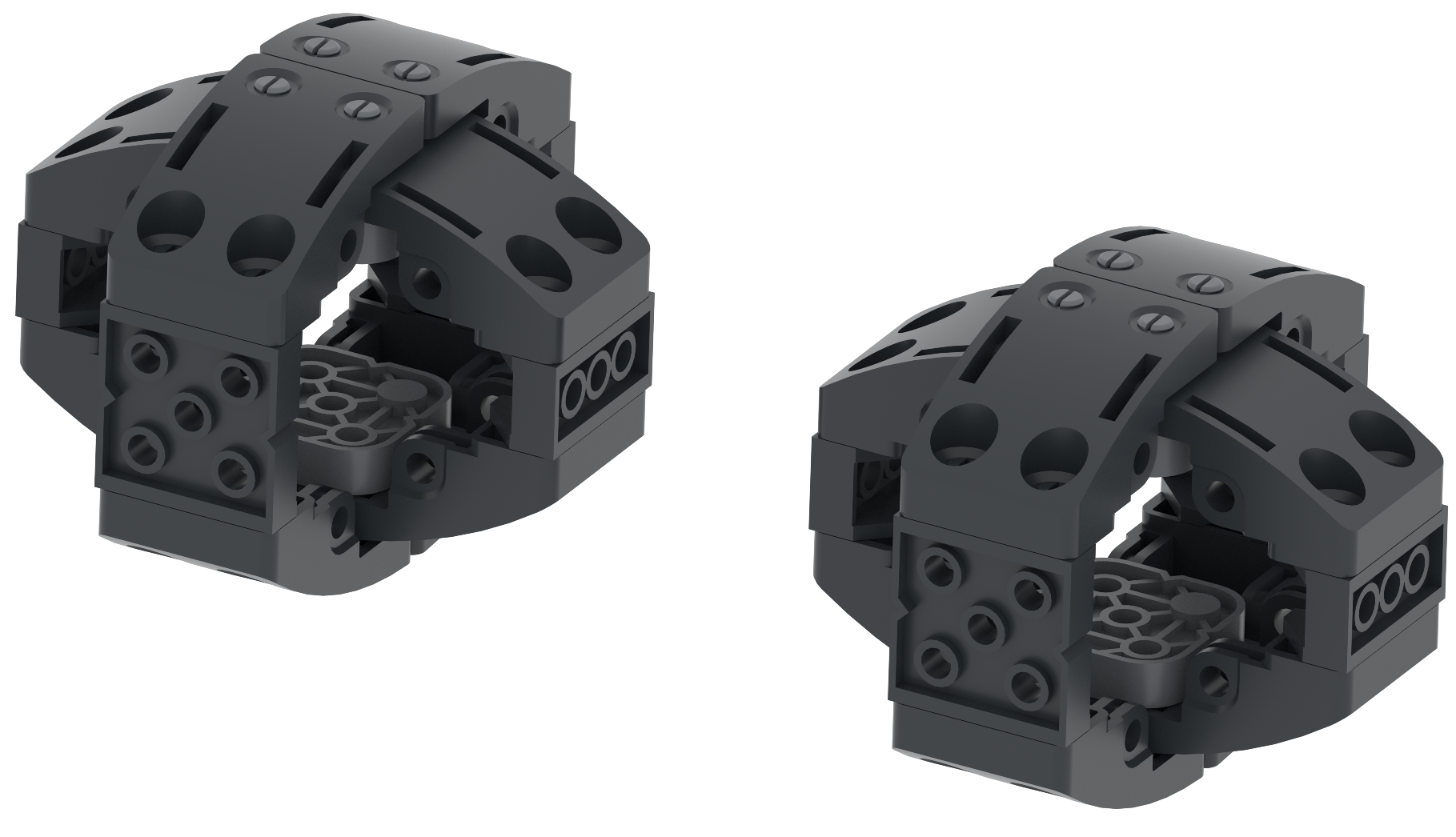
Rock game objects Facilitate conversations about driving strategy as students are practicing. You may want to allow extra time for Play Part 1, to enable all students to have enough time to get comfortable with triggering the landslide and moving a rock, so that they can begin to think about strategy. Encourage teams to look at what others are doing around the room, so that they can learn from other teams' experiences as well.
- What have they figured out through practice that has helped them be successful?
- What helps them trigger the landslide in a more predictable or controlled way? Why might that be helpful in the competition?
- What strategies make driving the robot to move the rocks easier? Faster?
- RemindRemind students that they should choose one small change to make to their strategy or robot design at a time as they are iterating through practice. Trying to change many things at once may make it unclear what is working well, and what is not. Being systematic about it, and documenting data about their practice driving can help them to make good data based decisions in practice and for the competition.
Remind students that even though there is one driver at a time, that driver represents the team, so all members of the team should be aware of what strategy the driver is using. Communication and compromise are important to developing a team strategy, so remind students to listen to one another and try to be flexible when it another teammate is sharing ideas. When they are offering an idea, do so in a calm and respectful tone, and clearly explain or show what you mean using the robot.
- AskAsk students about why using a robot to clear rocks and debris as a result of a landslide would be helpful. What attributes would a real robot need in order to do this heavy work efficiently and safely?
Mid-Play Break & Group Discussion
As soon as every group has triggered the landslide and moved one rock to the Red Tile, come together for a brief conversation.
Now that students have practiced driving their Hero Robots to trigger a landslide and move a rock out of the roadway, talk about the different driver or design strategies each team used to accomplish the task. Have each team share their strategies, and ask questions like:
- How did your team trigger the landslide? Did it matter where your robot made contact with the green beams on the front of the mechanism?
- What is one thing your team struggled to figure out during your practice? How can we help solve that problem together?
- What is something you saw or heard another team do that you'd like to know more about?
Then, introduce the Landslide! Competition:
- The goal of the competition is to score as many points as you can by triggering the landslide and moving the rocks to the Red Tile, in a one minute match.
- Each task is worth 1 point: triggering the landslide and moving each rock to the Red Tile, for a total of three possible points.
- Teams will apply what they learned in practice to help them score the most points they can in the competition!
- Note that in the event of a tie score, the fastest time will be used as the tie breaker. Teams can consider this as they prepare for the competition.
Talk about how teams can use what they learned in practice to help them develop a strategy for the competition.
- How will your team work together to be sure that you agree on a strategy for a match? If you disagree, how will you come to a compromise?
- How will your Hero Robot move on the Field in order to score points during a match?
Part 2 - Step by Step
- InstructInstruct students that they are now going to participate in the Landslide! Competition! The goal of the competition is to score as many points as you can in a one minute match by triggering a landslide to release the rocks, and moving both rocks to the Red Tile on the Field.
Use the Landslide! Competition Activity (Google / .docx / .pdf) as a guide for students as you engage in the competition.
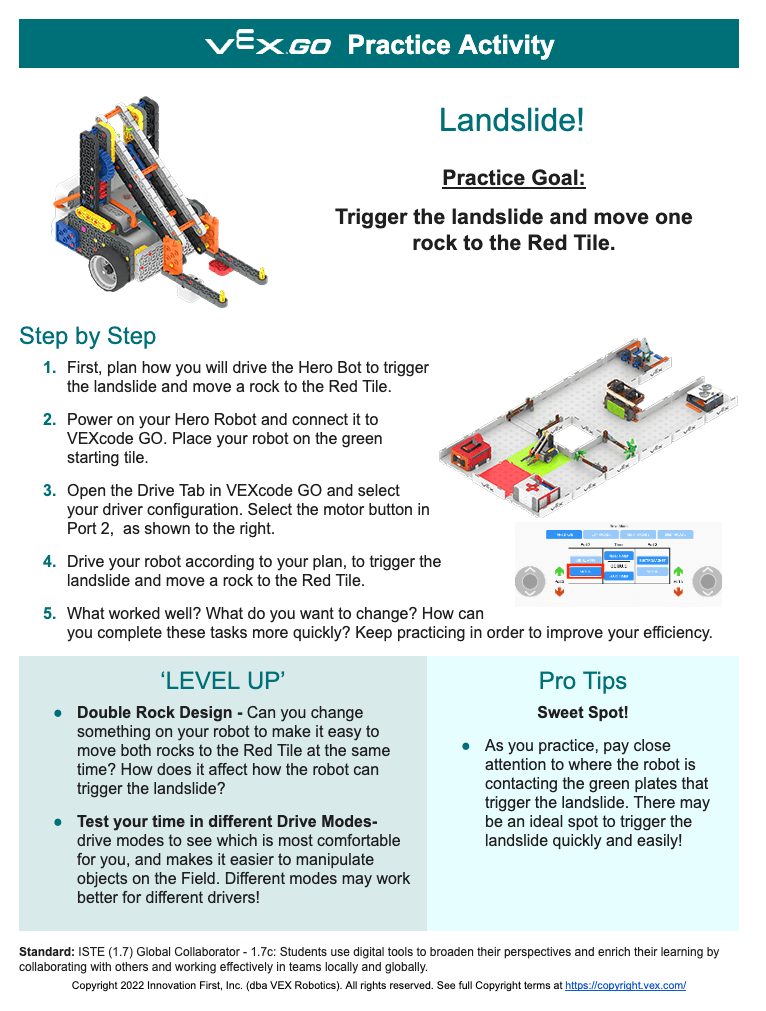
Landslide! Competition Activity - ModelModel for students how they will participate in the competition matches, and how the competition will run in the classroom.
To learn more about running a VEX GO Classroom Competition, see this article.
-
Model how to setup the Hero Robot on the Field to begin the match.
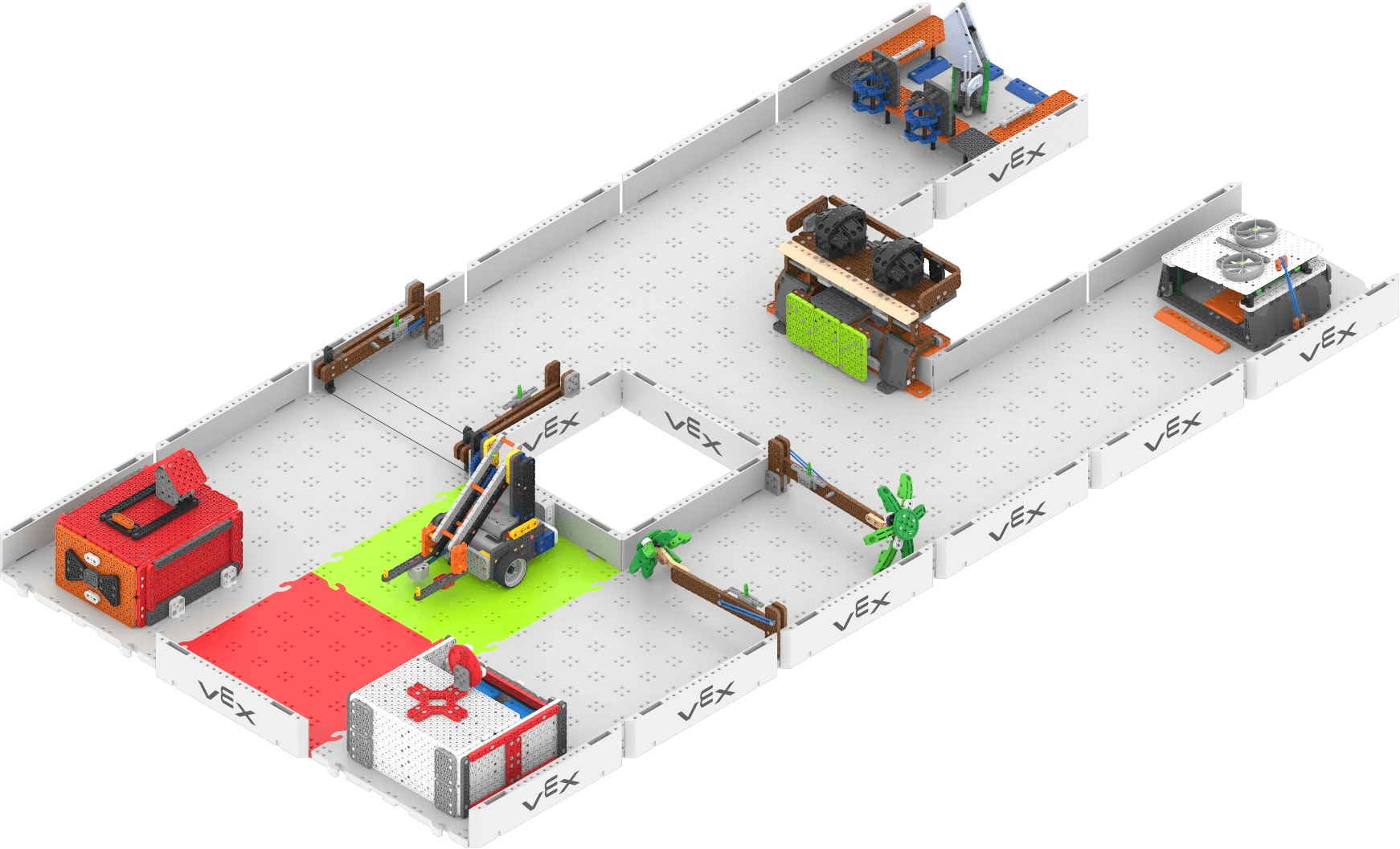
Field Setup - Share with students the match order and expectations, so that they know what they should be doing during the competition before and after their turn to drive.
-
You can use the Match Order template to show teams the order in which they will be competing. You can also use this sheet as a way to keep track of the score after each match. Try to have enough matches so that each student gets a chance to drive the robot at least once.
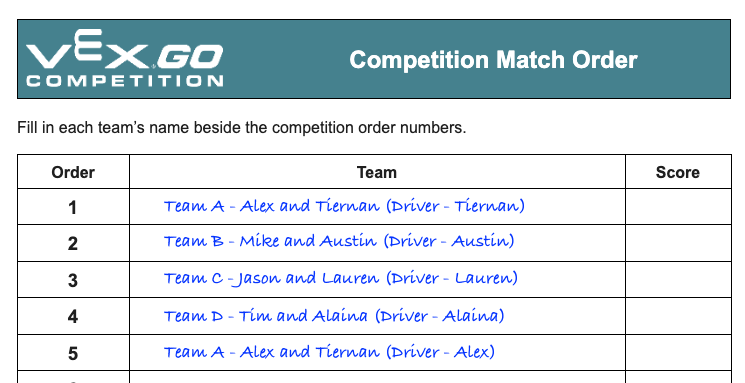
Example of a match order sheet - Demonstrate for students how you will operate the timer, and what to look and listen for to know when to start and stop driving their robots on the Field.
- Show students where they can be seated during the competition matches. If you have practice areas or other spaces students can be in during the competition, show them these areas as well, and explain how they are to be used.
- Review expectations for how to be a respectful participant in the competition. Encourage students to cheer for one another, and to be excited about the competition – this is meant to be a fun classroom experience! Be sure that students are showing good sportsmanship before, during, and after each match.
-
- Model how a match is run. Start the timer, and drive the Hero Robot on the Field to score points by completing the tasks on the Field. When the timer reaches one minute, stop driving. At the end of the demonstration, count the number of tasks that were completed, and total the score with students.
- If you are using a VEX GO Leaderboard, show students how the scores will be entered and displayed on the Leaderboard.
- Note: Since fastest time will be used as a tie breaker, for teams that score all 3 points during their match, note the time of the run as well as the score.
-
Model how to reset the Field for the next match. The rocks should be returned to the platform on the Landslide tile, and the platform should be lowered back into place, as shown in the Field setup image above. Use this image of the landslide Tile for reference.
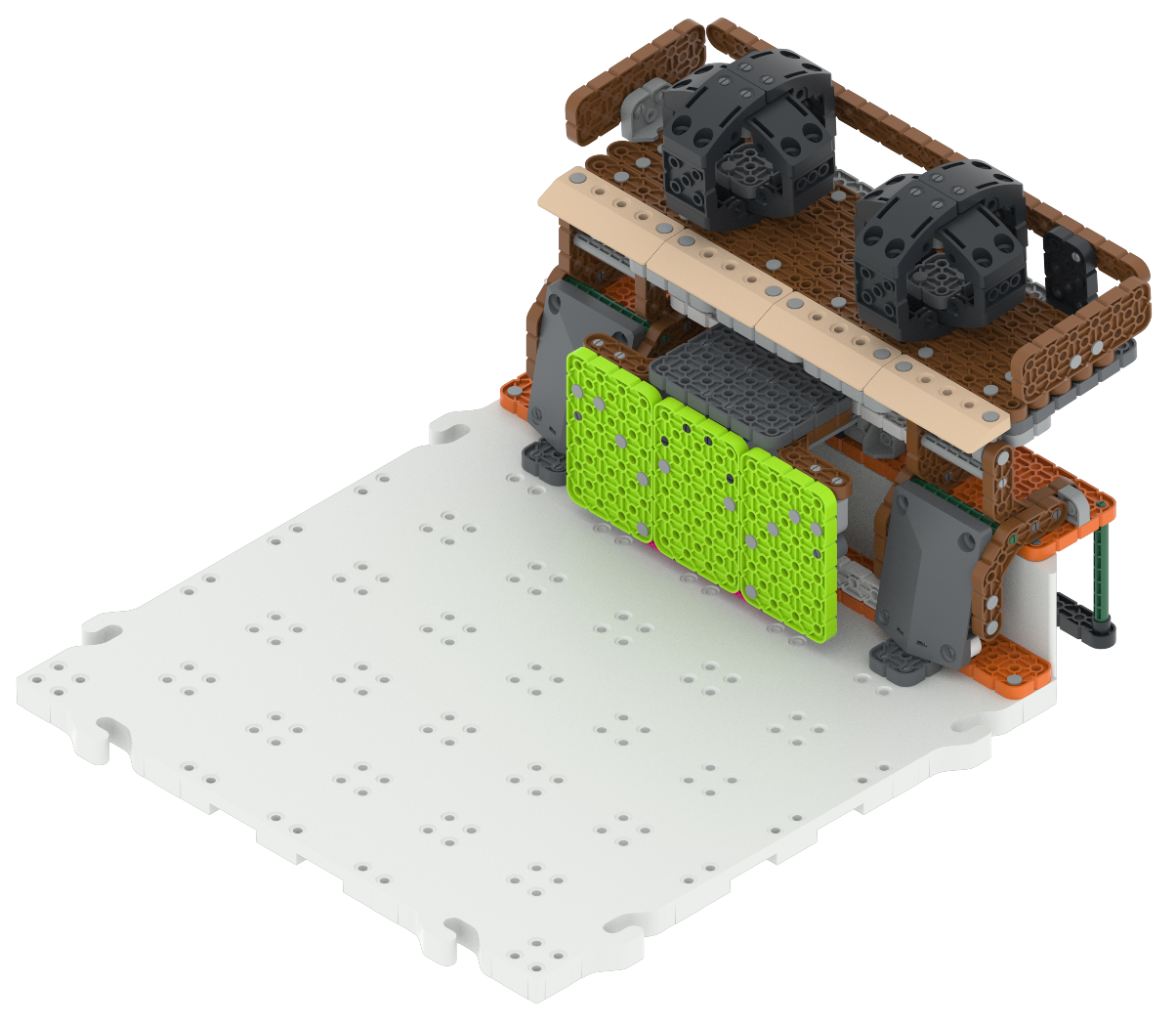
Starting position of the landslide and rocks on the Field -
Model for students how to plan a path together in their team, to begin their strategy discussions. You can use this image of the Field to help facilitate the discussion, and give students a place to trace their path away from the game Field itself.
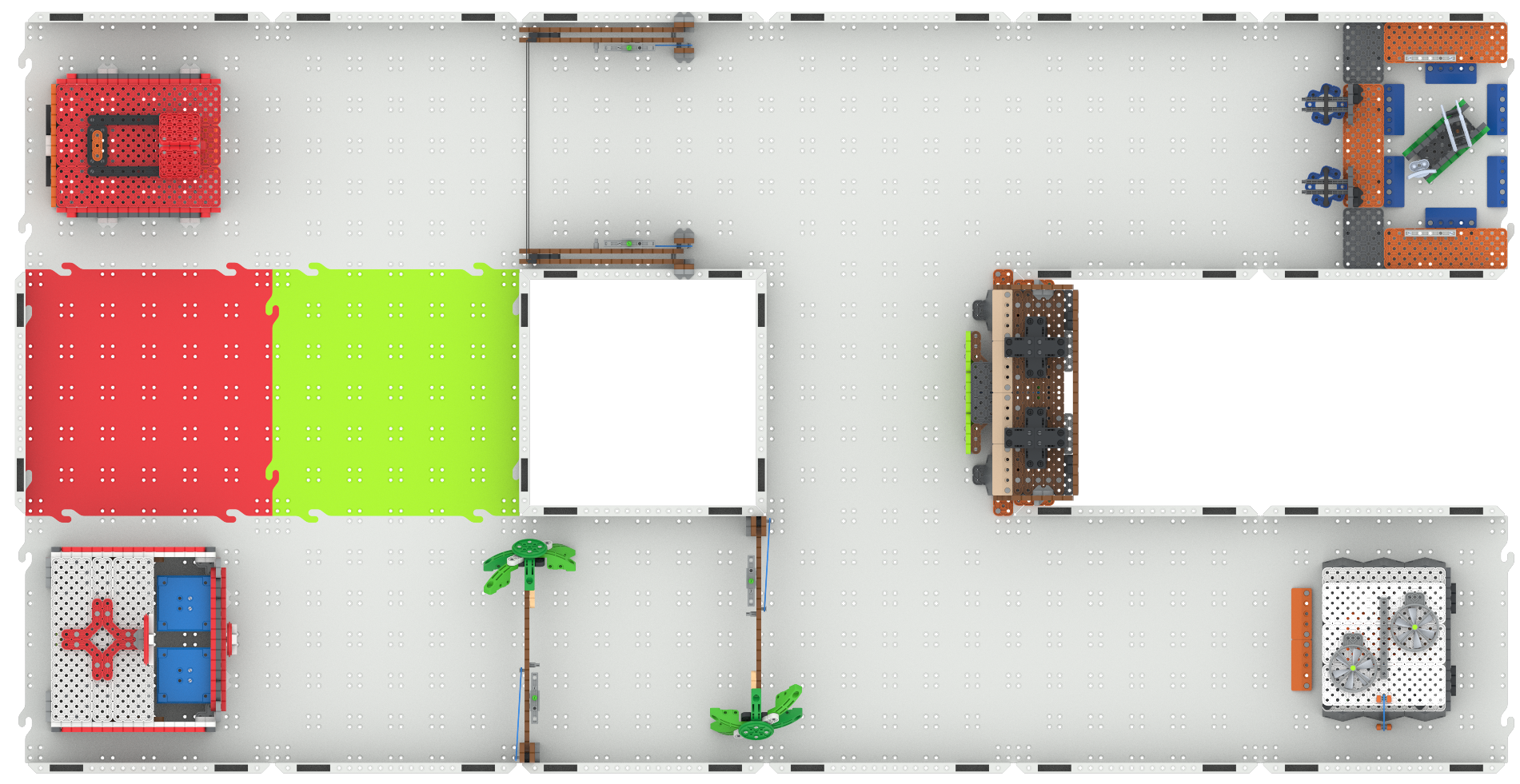
Plan a path for the robot
-
- FacilitateFacilitate Facilitate the classroom competition matches, and engage students in conversations about their driving and collaboration between matches. Use discussion prompts like:
- Before the start of a match:
- Which team member will be driving? Can you explain your strategy, or what you are going to try to do, in this match?
- What is one thing you are going to try to do the same as your practice or previous match? Why?
- What is one thing you are going to try to do differently than your practice or previous match? Why?
- During a match:
- Watch how the driver is controlling the speed of the robot. What do you notice?
- Watch how the driver is interacting with the landslide mechanism and moving the rocks to the Red Tile. What do you notice?
- After a match:
- What is something you learned from your driving that you will use in your next match?
- What is something you learned from watching another driver that can help you in your match?
- Before the start of a match:
- RemindRemind students that while they are watching other matches, they should be engaging with what they see. Not only can they encourage other teams and demonstrate good sportsmanship, they can continue to learn about the competition. As they watch other matches, encourage students to compare and contrast what they see happening with what they did during their match. What is working better or worse, or is it another way to achieve the same result? There are many ways to solve a challenge!
Remind students that they can highlight positive teamwork and collaboration that they see happening around them also. Offer moments for students to give shout outs to their teammates or classmates for strategy, robot design, collaboration, and teamwork!
- AskAsk students to think about how they have grown as a teammate from the first competition to this one. What has gotten easier for them? How have they become better communicators and listeners? How will that growth help them in other places, like school, home, or an after school activity?